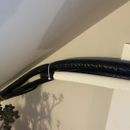Air Leakage Through Minisplit Condensate Line
We are in the middle of a blizzard here outside of Boston and I was walking around checking output temperatures of all of my mini split heads when I realized that there was a significant cold draft coming from my FS 06 1:1. This is when it was not blowing hot air. This is not from the wall penetration as you can see the lines that runs along the wall which I have yet to cover up. Has anyone experienced significant air leakage through condensate lines? This is of course during a blizzard with winds up to 70 miles an hour But I could imagine that at other times there is air coming through that condensate line.
GBA Detail Library
A collection of one thousand construction details organized by climate and house part











Replies
This could also have been due to defrost mode. I thought there wasn’t supposed to be cold air in defrost mode but my FS09 just went into defrost mode and there is significant cold air coming from the unit.
It looks to me like all the water is draining out of the drain line. Well dah isn’t suppose to actually no you want to trap some water in the line that will block any air from coming in the tube.
You need to be sure the highest point of the trap is a few inches below the drain pan in the mini’s head. If you could find enough slack to hold about 3 inches of water in the line near the arrow in this photo that should do the trick.
Note the condensate tubing it very delicate if you drag it against a sharp edge you could make tiny holes that will leak water.
Walta
Walta, thanks for the reply. I did not read about any traps for condensate lines. How would that still drain if it’s supposed to be gravity fed without a pump. What do you do with lines that go straight out of the house?
Yes the water will still drain thru a trap.
If you look at this photo whatever amount of water enter the trap at the inlet an equal amount of water will exit the trap at the overflow.
The only way to get in trouble is if any part of the trap happens to get above the drain pan in the mini split head then the water would over flow the drain pan as a leak.
Keep the trap inside the heated space so it will not freeze.
Note the water in the trap may evaporate over the winter if that happens put some water in the drain pan that will seal the trap again.
Note ever sink drain in your house has a trap much like we are talking about.
https://en.wikipedia.org/wiki/Trap_(plumbing)
Walta
I don't think this would work.
I've had trouble with drains that had a slight dip, thus forming an unintentional P trap, in them not draining properly. The issue is that without an air break before the P trap, water won't be able to flow down to it. You can do a P trap, but it needs a T before the trap with a small riser open to air for it to work properly. Also a P trap will dry out during the heating season.
I've never noticed cold air through a drain line. Since it is not needed in the heating season, you can always try to plug it on the outside and see if that is the culprit.
Thanks Walta. I wasn’t aware of these needing p traps. What about when the Lineset is going straight on the back of the wall? Doesn’t seem possible.
I have also had issues with traps in condensate lines. Stuff can grow in the condensate water and plug things up. I've seen that many times.
What you can do is build a sort of guard for wherever the condensate line goes, by mounting a decent size (1.5-2 inch or so) pipe of mabye 2-3 feet high, mounted vertically. Bring the condensate line in through a reducing T or tight fitting hole in the side about halfway down the vertical pipe. This will greatly reduce the air blowing up the line, although you may still get some air movement in really high winds. Remember that the air speed indicators on airplanes use an arangement with a small tube pointed in front of the aircraft (known as a "pitot tube" or "probe"). The air pressure created by the motion of the aircraft is what drives the air speed indicator. Wind blowing into a tube pointed into the wind will act the same way.
Bill
Thanks Bill. I was also sent this which may be easier:
https://www.supplyhouse.com/EZ-Trap-83180-EZT-180-Waterless-In-Line-MiniTrap-without-Brush?fbclid=IwAR0rIJX41tMA78bKFA5L6t991GzOiOqRRz0-JOcXTR77Alk3Yk6jEqxhw_E
It’s a trap that goes at the end of the corrugated tube. Won’t work for my pvc but I can easily plug that.
That trap assembly is probably worth a shot. I would just try to protect it from freezing. It is easier to freeze a valve shut than it is to plug a pipe, so the trap/valve assembly will be a weak spot in that regard.
Bill